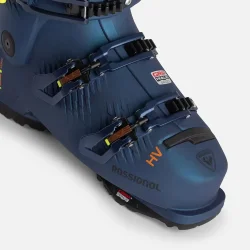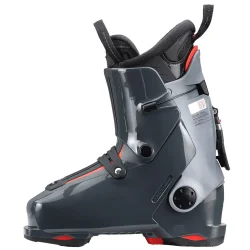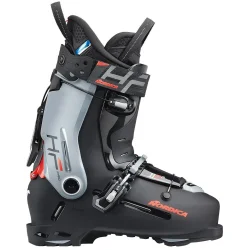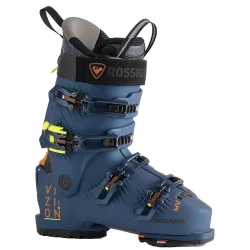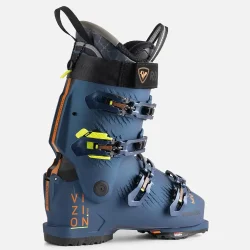Find your correct size through our ski boot size guide! To download it, click on this link.
Tips for choosing:
- What is the difference between sizes 26 and 26.5 on a ski boot?
The difference is related to the (removable) insole. There is no difference in shell and no difference in liner. Several manufacturers are even now offering to buy the boot in double size as 26 / 26.5.
On touring ski boots, on the other hand, some brands offer two different liners between half sizes.
- Do you have to take it longer so as not to be tight?
No because the liner tends to loosen up a bit, so the ski boot will become larger over time. Prefer thin and new ski socks with new boots.
FULL GUIDE TO CHOOSE YOUR SKI BOOTS:
Ski boots are the most important part of your skiing equipment. They are the essential link between your body and your skis. Choosing the right shoe will make you progress more easily. But what boots should you choose when facing a very wide choice (several hundred boots on Montaz.com)?
Therefore we offer this guide to help you find the ideal ski boots for your feet and your skiing.
Ski boots adapted to your body type:
- Foot length:
1) Place a sheet of A4 paper against a wall or print our size guide.
2) Bare foot, put your foot on the sheet, your heel should touch the wall. The knees should be bent slightly forward.
3) Draw a line in front of your longest toe.
4) Remove the sheet and measure the length between the edge of the sheet and the line you have drawn. This gives you a length in mm, for example 281mm and so a size 28.
Repeat on the other foot (you will no doubt have surprises!) And keep the biggest length only (between the right foot and the left foot).
Size information: between a size and a half size the volume of the shell remains the same, the only difference is that the insole will be a little thicker on the lower half size to give a little more volume in thickness.
Find all our ski boots according to your foot length in mm:
160 / 190 / 195 / 200 / 205 / 210 / 215 / 220 / 225 / 230 / 235 / 240 / 245 / 250 / 255 / 260 / 265 / 270 / 275 / 280 / 285 / 290 / 295 / 300 / 305 / 310 / 315
- The metatarsal width:
This width corresponds to the widest part in mm at the level of the forefoot (metatarsus). You can measure it by placing your foot on a ruler or using our ski boot size guide.
Find our selections of ski boots adapted to your foot width:
- 95 to 98 mm: Our ski boots for narrow feet
- 99 to 101 mm: Our ski boots for classic / average feet
- 102 to 104 mm: Our ski boots for wide feet
- 105 to 106 mm: Our ski boots for extra wide feet
Finally, some ski boots are especially designed for women, find our selection of ski boots for Women.
Choose the right flex index for your ski boots
The stiffness of the boot or the flex is expressed from 50 to 150 and is chosen according to the ski level, the weight of the skier and the ski program (leisure, racing, freeride ...). The higher the stiffness, the more the volume inside the shell will decrease, although there are exceptions for skiers with wide feet. Usually a higher flex index will allow a better reactivity of the boot.
A powerful skier (Freeride or Racing) or with a certain size / weight will prefer to take a ski boot with a high flex index that will be able to support the pressure. Rigidity is a matter of personal appreciation (every brand has its own flex index). At Montaz we are used to comparing flex to a car suspension: the faster we go, the stiffer the suspension must be.
Our ski boots according to their flex index:
- From 50 to 80: Boots for Beginners to Intermediate
- From 80 to 100: Sporty boots
- From 100 to 140: Boots for Experts
- Over 120: Boots for Competitors
Your ski boots according to your skiing practice:
The skier's program is not directly linked to flex. It depends mainly on the skier's muscular strength because a good technician does not necessarily push hard on his shins. It is therefore possible to choose your ski boots according to your practice rather than by stiffness.
In general a freestyler takes a softer flex than a freerider which itself takes more flexibility than a competitor:
- our Leisure Ski Boots
- our Freestyle ski boots
- our All-Mountain / Performance ski boots
- our Competition / Racing ski boots
- our Freetouring ski boots
- our Ski touring boots
The choice of ski boots brand:
Montaz offers a very wide choice of ski boot brands including Atomic, Dalbello, Fischer, Full-Tilt, Head, Lange, Nordica, Rossignol, Salomon and Tecnica.
Also, find a wide choice of ski touring boots from the following brands: Arc'teryx, Dynafit, K2, La Sportiva, Roxa, Scott or Scarpa.
Each brand has a specific fit but also unique designs to suit everyone.
Montaz's advice to make you feel good in your boots
For a new ski boot we choose a pair of thin ski socks because the liner of the boot will loosen up over time.
- For an easy entry, pull the tongue on the right or left, but never on the front (as most users do). The shell opens and your ankle can pass.
- In order: first close the bottom buckles, then those on the shin and finally tighten the scratch. Be careful with the overlapping of the shells.
- If you feel discomfort on the tongue, pull it slightly to place it.
- Check if you feel good or not. You should not have lateral play inside the boot, you should feel good support at the ankle and the heel should not rise too much (and not at all for strong skiers).
- During your ski day, at the ski lifts, remember to loosen the buckles as this will restore better blood circulation and warmth.
Montaz solutions for pain in certain areas of the foot or leg:
- Boot Doc Scanner. In store, your feet are scanned with our Boot Doc scanner to quickly offer you the ski boots matching the specific morphology of your feet.
- Cramps or painful sensations under the foot? Use preformed or thermoformed soles to reposition your foot inside the boot. You will also benefit from better precision in skiing.
- Sore shins? Use pre-molded soles to reposition the tibia in the big toe kneecap axis and if this is not enough use tibia gel protections which will relieve the pain associated with pressure on the tibia.
- Malleolus hurt? Again, use a sole that matches your arch to reposition your malleolus. If that is not enough Montaz can deform your boot / shell using suitable tools.
- Cold feet and or tingling legs? It is the symptom of a too narrow shell, the blood has difficulty circulating in the forefoot and the pain comes after a few minutes of use. Montaz can enlarge the shell of the boot in order to gain the few missing millimeters.
- Cold feet despite a suitable shell? Some people have big circulation problems and despite a comfortable boot in normal times, the intense cold is a problem. Use heated insoles at this time to benefit from optimal thermal comfort and keep your feet warm and dry. Also don't forget to dry your boots after a day of skiing.
- Not all socks are created equal. Prefer double size ski socks (ex 40-41) which will age better when washed. Finally prefer thin and technical socks to thick socks.
Our Bootfitting Workshop services:
- Shell deformation: by heating the shell and using specific tools to remove hard spots.
- Shell milling: By removing matter in the thickness of the shell in order to create additional spaces while maintaining precision.
- Liner injection for a personalized boot in the extreme.
All our Workshop and Bootfitting prices can be found here.
Be sure that operations we perform on the shells or liners do not affect the performance of the ski boot or the liner.
If you still have doubts regarding the choice of your ski boots, we invite you to go to our shop or to contact our Customer Service for personalized advice at (+33)4 79 72 94 97 (Cost of a non-surcharged call to Metropolitan France).




